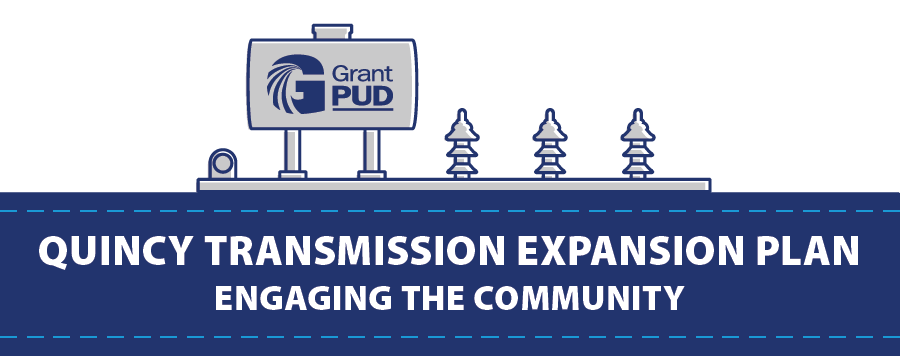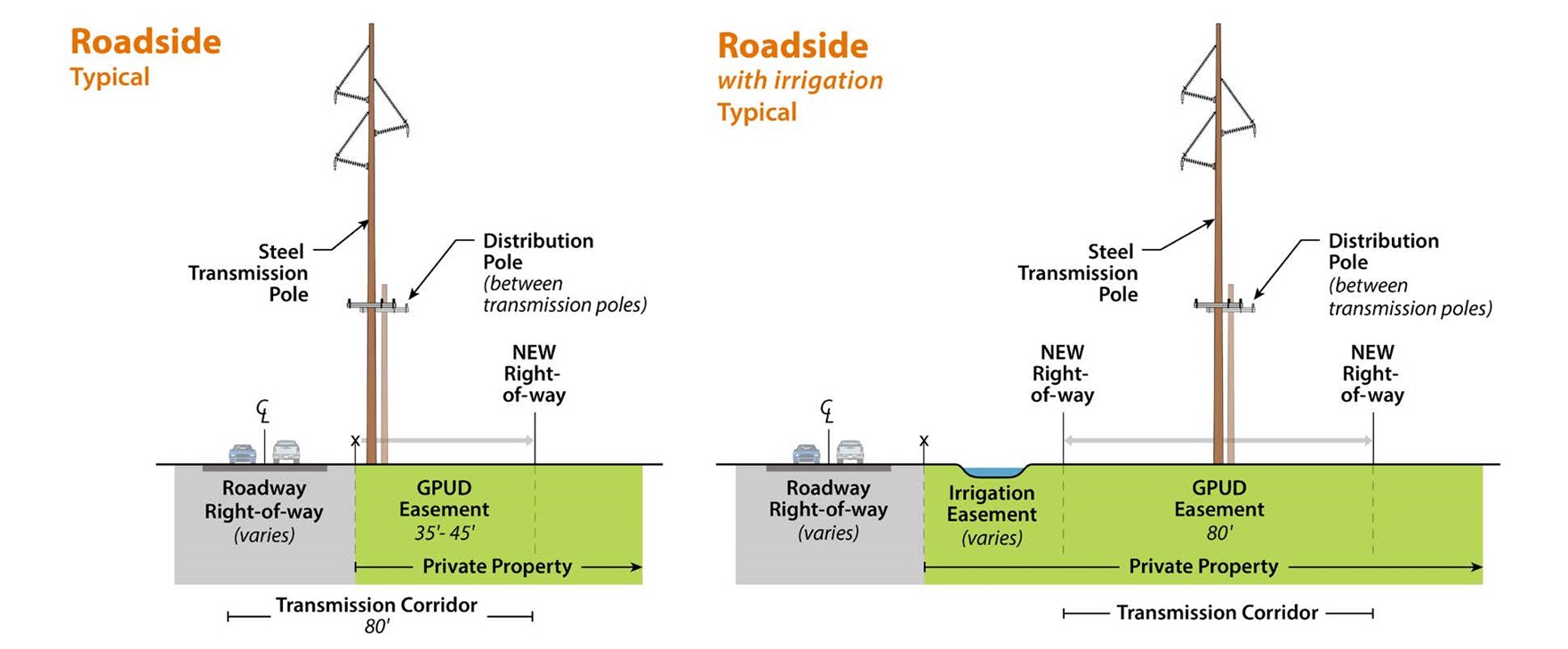Quincy Transmission Expansion Plan
Grant PUD’s Quincy Transmission Expansion Plan takes a proactive approach to managing the county’s power system. The plan includes projects that will increase electrical capacity in the Quincy area to meet future energy needs. Click the buttons in the graphic below to learn more about the projects.

- Columbia to Mountain View-
- Monument Hill to Rocky Ford -
- Mountain View to Monument Hill -
- Monument Hill Loop #1 -
- Mountain View Loop #1 -
- Wanapum to Mountain View -
- Monument Hill Switchyard (new switchyard) -
- Mountain View Switchyard Expansion -
- Wanapum Switchyard Expansion -
- Rocky Ford Terminal Modifications -
Who do I contact for questions regarding the QTEP transmission routes?
Please contact Chuck Allen, Grant PUD's Senior Manager of External Affairs and Communications by e-mail: callen@gcpud.org, or call 509-766-2513.

Quincy 230kV Transmission Improvements Project
Overview:
Quincy Transmission Expansion Plan (QTEP) consists of 10 individual projects. QTEP projects will provide additional transmission capacity necessary to reliably serve the growing demands in the Quincy Area.

Need and community benefits:
To keep up with growing demands for electricity, Quincy’s power grid needs greater capacity and redundancy, with more connections to local power sources like the Wanapum Dam.
The Quincy Transmission Improvements Projects would add greater capacity and redundancy to the Quincy power grid. This allows us to continue providing reliable power to homes and businesses, even as demand grows. A more redundant system allows for maintenance activities and ensures the power stays on for businesses and homes during outages.
What’s happening now?
Grant PUD is progressing with design, permitting, procurement of long lead material and right-of-way acquisitions, all contributing to the overall QTEP program. Mountain View Switchyard Expansion will be the first QTEP project to begin construction in 4th quarter of 2025.
Wanapum to Mountain View
Overview:
To meet rapidly growing electricity demands and improve reliability, Grant PUD plans to build a new 31-mile, 230kV transmission line from the Wanapum Dam to the Mountain View Substation near Quincy. The new transmission line will be aligned along existing roadways and utility corridors. This project will bring additional electrical capacity to the Quincy area.Need and community benefits:
Quincy’s power grid needs greater capacity and connections to local power sources like the Wanapum Dam to keep up with rapidly growing electricity demands. The new transmission line will provide that connection, increase electrical capacity, and help Grant PUD provide reliable power to homes, farms, and businesses.
This project is part of Grant PUD’s larger Quincy Transmission Expansion Plan that takes a proactive approach to managing the county’s power system, creating a more robust grid with increased electrical capacity to meet future energy needs.
What's happening now?
Grant PUD is currently engaging with local landowners to acquire rights-of-way along the alignment to build, maintain, and operate the Wanapum to Mountain View transmission line. Additional environmental review, design, and permitting will occur between now and mid-2026. Material procurement and construction could start as early as 2026.
Construction of the new transmission line is scheduled to begin in mid-2028 and will include placing 100- to 115-foot-tall steel poles roughly every 500 feet along the entire alignment. Smaller poles, which carry distribution and fiber optic lines, will be placed halfway between each transmission pole along the corridor.
Read more: Wanapum–Mountain View: Right-of-Way Acquisition Process (PDF)
Frequently Asked Questions
Public Utility District #2 of Grant County’s (Grant PUD’s) Quincy Transmission Expansion Plan (QTEP) takes a proactive approach to managing the county’s power system. QTEP includes projects that will increase electrical capacity in the Quincy area to meet future energy needs.
QTEP consists of the following projects:
• Columbia – Mountain View 230kV Transmission Line
• Mountain View – Monument Hill 230kV Transmission Line
• Monument Hill – Rocky Ford 230V Transmission Line
• Wanapum – Mountain View 230kV Transmission Line
• Mountain View 230kV Loop #1 Transmission Line
• Monument Hill 230kV Loop #1 Transmission Line
• Monument Hill Switchyard
• Mountain View Substation Expansion
• Wanapum Switchyard Expansion
• Rocky Ford Terminal Modifications
The purpose of the QTEP transmission line projects is to provide new path for energy to flow from Grant PUD’s Wanapum Switchyard and also provide operational flexibility for Grant PUD’s facilities in Quincy.
QTEP is estimated to cost approximately $211 million.
Transmission lines are key elements in the electrical system. These lines transport high-voltage electricity from power generation sources, such as Grant PUD’s Priest Rapids and Wanapum hydroelectric dams, to local substations in our communities.
Grant PUD is required to ensure that its transmission system can reliably serve customer power needs under all operating conditions, including during times of peak use (maximum demand). The proposed transmission lines will:
1. Provide capacity to deliver Grant PUD hydroelectric power to growing electrical loads (i.e., demand) in Quincy
2. Increase transmission system reliability
3. Improve performance of Quincy’s energy system
As part of the utility's Capital system, costs are recovered over time from retail rate revenue of our customers.
Grant PUD is currently engaging with local landowners to acquire rights-of-way along the alignment to build, maintain, and operate the transmission lines.
The preferred routes were identified and shared with the general public at two open house events in 2022. Grant PUD is progressing with acquiring right-of-way, advancing design, conducting environmental review, and obtaining permits for the new transmission line projects.
After permitting and right-of-way acquisition, Grant PUD anticipates beginning material procurement as early as 2026, with construction to follow.
Steel poles will be used, and they will have a natural rust-colored finish. There will be both transmission and distribution poles and lines along the corridor. The transmission poles and lines will be about 100 feet tall, and the distribution poles and lines will be about 40 to 65 feet tall. All but a very small area around the poles can be utilized for existing uses. Irrigation canals require pole placement about 40 feet away from canals to allow access for canal maintenance. See typical roadside pole configurations.
More Info: Wanapum–Mountain View: Poles/Power Line Scenarios (PDF)
Grant PUD has yet to propose the locations of the poles. During subsequent planning phases, Grant PUD will develop conceptual designs that will provide information such as proposed angle locations and the side of the road on which the lines could potentially be located for the selected routes. The subsequent phases of the design process will determine the requirements for new or expansion of existing easements. See example of a typical pole placement.
Underground transmission lines are extremely costly to build and repair. Underground lines can cost up to ten times as much to build as overhead transmission lines, depending on terrain, environmental constraints, and other factors, The environmental impact of digging trenches to bury cable can also be significant.
Additionally, the reliability of underground transmission lines is a major question across the United States, as relatively few have been constructed other than in dense, urban settings. A problem in a buried line would take much longer to locate and repair than a similar problem in an overhead line.
Grant PUD will negotiate directly with private property owners to acquire the necessary easements and rights-of-way. Experience shows that fair and reasonable agreements are reached after an appraisal process that takes into account the features of each particular property. It is in Grant PUD's interest to make every effort to reach agreements quickly and fairly.
Right-of-way acquisition gives permanent easement rights to Grant PUD to use the land or property to build and maintain the transmission line. Landowners are paid for the use of the land and retain ownership of the land, but they give Grant PUD permission to use the land indefinitely. If the property is sold, the new owner is bound to the terms of the easement. In most cases, Grant PUD will seek to acquire a small corridor of land, just enough to place poles on the property and for the wires attached to the poles. In addition to still owning the land, landowners can use the land except for a small area around the poles. There are some limitations to what can be placed under the lines that will run between the poles. For example, buildings or trees would not be allowed.
Read more: Wanapum–Mountain View: Right-of-Way Acquisition Process (PDF)
Right-of-way acquisition is a multi-step process that includes the following steps:
Connecting with Individual Landowners: Grant PUD begins discussions with individual landowners by phone or in person about obtaining Right of Entry onto their lands to conduct the necessary surveys and studies, as well the process of purchasing right-of-way.
Land Surveys and Studies: Surveyors, technical staff and engineers visit each property to identify potential pole locations and determine ground conditions.
Appraisals: From there, with the assistance of independent appraisers, appraisals are completed to determine the fair market value of the property that Grant PUD wants to acquire easement rights to.
Compensation Offer for Easement Rights: Grant PUD makes an offer based on appraisals by independent appraisers of like properties to establish fair market value of the easement area. Offers are typically 25- 40% of the appraised fair market value.
Negotiating Final Agreement: Grant PUD and the landowner negotiate a final agreement for the right-of-way. Property owners may hire a professional agent to evaluate Grant PUD’s offer.
Read more: Wanapum–Mountain View: Right-of-Way Acquisition Process (PDF)
As a last resort, Grant PUD may pursue a process called condemnation if an agreement cannot be reached with a landowner. Condemnation is a rarely used process under which a judge can decide whether the right-of-way is needed and its value. Condemnation is part of a government’s right to acquire or authorize the acquisition of a private property for public use with just compensation to the owner. This is also referred to as eminent domain.
Read more: Wanapum–Mountain View: Right-of-Way Acquisition Process (PDF)
Except for emergency situations, property owners can generally expect the line to be accessed once a year by Grant PUD. Maintenance will be conducted if issues are observed during the assessment. Maintenance may include pruning trees that encroach in the right-of-way. In the event of an outage the line could be accessed as line crews troubleshoot the root cause of the outage.
Yes! Land within the easement may be used in ways that do not interfere with the operation, maintenance, or construction of the line. We intend to minimize impacts to agricultural operations during the design, construction, and operations and maintenance of the transmission line. Since agriculture operations vary along the route of this project, we plan to work through specific land use and operational concerns with each individual property owner.
EMF, which are associated with transmission lines and substations, surround us every day. They are natural consequences of our use of electricity. These fields are produced by electric ranges, lights, motors, televisions, microwave ovens, hair dryers, and all other devices that use electricity. Numerous EMF studies have been conducted during the past 30 years to determine if exposure to EMF is harmful. More than 20 scientific review panels have analyzed this body of research and concluded that none of these studies has established a cause-and-effect relationship between EMF and any harmful health effects.
There are no federal/state regulations or NESC requirements specifically limiting exposure to electric and magnetic fields.
Grant PUD will be happy to provide scientific literature on EMF if requested.
GPS signal interference should not generally occur as a result of transmission lines. GPS devices continuously pull signals from multiple satellites—not just one. If farming equipment has a GPS unit, the equipment should work as properly when underneath a transmission line as it does when not near a transmission line. There is potential for a signal to be temporarily blocked, although the signal should come back within a few seconds as the farm equipment continues to move.
The Institute of Electronics Engineers (IEEE) previously published a white paper titled “Use of Global Positioning System (GPS) Receivers Under Power-Line Conductors,” which evaluated a similar question. The potential effects of electromagnetic interference and/or signal scattering from overhead conductors are evaluated analytically and with some practical measurements under transmission lines. Based on the analysis presented in the IEEE white paper, it is unlikely that power line conductors will interfere with use of the GPS satellite signals.
The effect of a transmission line project on property values can be significantly reduced or eliminated by setback distance, intervening landscaping, shielding of visual effects, and integration of the transmission line corridor into the neighborhood (trails, for example). Recent studies analyzing the effect of transmission lines on property values have concluded that transmission lines alone typically do not have a significant negative impact on property values.
Generally, transmission lines do not cause interference with radio, television, or cellular phone signals. However, some potential interference sources do exist, including corona discharges, shadowing, and reflection.
Corona discharges occur when electric fields near an energized transmission line conductor produce small electrical discharges that ionize nearby air. The air ionization caused by corona discharges can result in the formation of audible noise and radio frequency noise. If the discharges are excessive, the audible noise can reach annoyance levels and the radio frequency noise can cause interference with radio and television reception. The potential for radio and television signal interference, however, is largely dependent on the magnitude of the corona-induced radio frequency noise relative to the strength of the broadcast signals.
Shadowing and reflection effects are typically associated with large structures, such as high buildings, that may cause reception problems by disturbing broadcast signals and leading to poor radio and television reception. Although the occurrence is rare, shadowing and reflection may occur if a transmission structure is placed between your receiver and a weak distant signal. Most reception is now digital, which allows for multiple paths to a signal and lower probability of signal interference.
The NESC is an industry standard that provides minimum line design requirements including likely wind loads in the area. Grant PUD realizes that these are minimum requirements and has many years of experience designing new lines within the area to withstand high-winds.
Grant PUD receives an annual average of approximately 960 megawatts from Wanapum and Priest Rapids dams to serve the county’s demand for electricity. Our federal license to operate the dams allows for about 60% of those average megawatts to come from the dams’ physical output. The rest comes in financial form through long-term power-purchasing contracts with regional utilities. We currently use money from those contract sales to buy power from the wholesale market for our Grant County customers.
Grant PUD expects on a planning basis that by 2026 our county’s growing power needs will regularly exceed both the energy and financial benefits of our hydro projects.
Although we currently meet these expanding needs from wholesale power market purchases in the short term, we believe it is prudent to consider developing long-term contracts with wholesale power providers, and/or expanding our own power generation resources.
To learn more about how we expect to meet power demands in the future, please see our latest Integrated Resource Plan, which is updated every two years.
Grant PUD’s commissioners have determined that customers in the Residential, General Service (small business), Irrigation and Large General Service rate groups will be the first to enjoy the benefits of our hydropower resources. Customers in the other rate classes will also benefit from the same resources. However, under current policy, those in the Large Industrial rate class would pay incremental energy expenses through a cost-recovery process that is part of their existing rate.

